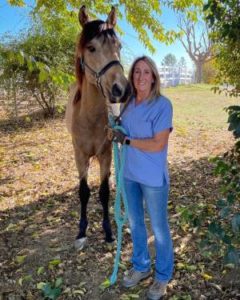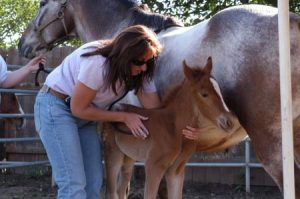
WHAT YOU SHOULD KNOW ABOUT …
Owning a horse is a big responsibility. It requires a commitment of both time and money. A new owner should be prepared to spend time grooming, exercising, and caring for the animal – or assume the responsibility to see that the basic care will be performed daily. Unless the horse is kept on the owner’s property, travel time to and from the stable must be considered. The costs of owning a horse can add up quickly as the owner provides shelter, feed, veterinary medical care, hoof care, and riding equipment.
Before buying a horse for their children, parents would be wise to assess their children’s commitment. Arrange with a local stable for riding lessons or the opportunity to participate in the supervised care of a horse for a month or two. If the youngster “sticks” with the chores of horse ownership, he or she is probably responsible enough to own one.
Before you purchase a horse, decide where to keep the animal and how much it will cost. In many instances, the purchase price is not as much as the annual boarding fee. If you live on property that can support a horse – legally and physically – be sure you have adequate stabling. If you live in a cold climate, consider boarding the animal, at least during the winter months, at a stable with an indoor arena. Riding in freezing weather is unpleasant and can be dangerous for both horse and rider.
What Kind of Horse Should You Get?
Because riding is a team sport – of the horse and rider, it is important that you buy a horse that suits the temperament and style of the rider. A nervous, fearful rider should have a calm horse that will not react in kind. A child should not have a horse or pony that will bolt. An experienced rider will want a sensitive horse that responds to the slightest commands.
Before you decide to buy a horse of your own, you should already have some riding experience or have taken riding lessons. Once you understand your riding abilities and limitations, you will be in a better position to choose a horse with a temperament that will suit you.
You should consider what type of riding you intend to do. “English” riders may want a purely pleasure horse for riding “on the flat.” Other “English” riders may want a horse that will jump or one that can be taken on the hunt field, or use in “English” or “Dressage” show events. “Western” riders may want a horse to use in work, in “Western” show events, or simply for pleasure riding.
Whatever style of riding you prefer, it is best if the first horse you buy is already “schooled.” First-time horse owners should avoid younger animals that require a lot of training. An older horse that already has the skills you need is usually a better buy for a first-time owner and younger rider.
Where Do You Look for a Horse?
A good place to buy a horse is at the stable where you ride or plan to keep the horse. The stable owner has an interest in keeping you satisfied and, in knowing your abilities and temperament, he or she can suggest a suitable animal.
Riding instructors can act as agents in locating a horse since it is essential to them that their students do well in competition. Breeders are another source. Generally they want to see their animals well placed and will make every effort to provide a horse you can enjoy. Almost every breed has a registration association that can direct you to breeders in your area.
A handy resource is the classified section of your local newspaper or the bulletin board of your local tack shop. However, here you have little knowledge of the seller and little recourse should the purchase prove unsatisfactory.
Trying Out a Horse
When going to look at a potential horse, as first-time buyer you should be accompanied by a knowledgeable horseperson. Together, observe the horse in the stall, pasture, loading, and hauling.
Temperament should be the most important characteristic to you. Look at the horse’s eyes and ears and general manner when it is brought out. Does it look alert? Be sure you observe the animal in a well-lit place, preferably outdoors in the sunlight. Watch the owner groom and saddle the horse. Does it stand quietly? Does it kick or bite? Do not buy a horse with bad stable manners.
Do not get on the animal right away. Ask the owner to ride the animal first. Watch how the animal acts when mounted – does it stand still or does it dance around? Ask the owner to take the horse through its gaits – the walk, trot, and canter. Does it look smooth? Does it toss its head or fight the bit? If you are buying a hunter, a jumper or another specially trained horse, ask the owner to demonstrate its skills.
If you and your advisor are satisfied that the horse is safe for you to ride, it is your turn to mount. Once again, observe how it reacts when you mount and how it reacts to your commands. Try out any special skills that the horse is trained to perform. This is a major investment and you should be allowed to test the animal thoroughly. You could make observations on a second visit that you did not see the first time.
Many times a brief trial period (7-10 days) can be arranged for the prospective buyer. This allows you to “test drive” the horse and see if the two of you are really compatible.
Even If You Fall in Love With a Horse
Do not buy it before the animal has been thoroughly examined by Dr. Garfinkel. Long-time horse owners almost always have Dr. Garfinkel examine any animal before purchase and first-time owners should certainly do so.
Dr. Garfinkel Will Check the Horse for:
- Age
- Suitability of the horse to its intended use
- General condition – alertness, medical status of the eyes, ears, heart, lungs, limbs, digestive system (including dentition), and coat
- Musculoskeletal system – limbs evaluated, conformation abnormalities noted, general medical status of the horse evaluated, and the condition of the feet, type of hoof trimming or shoeing observed, as well as the horse’s locomotion
- Internal and external parasites, such as intestinal worms and ticks
Discuss exactly what the pre-purchase examination will include so that the necessity of additional tests, such as radiographs, blood tests, drug tests, ultrasonography or endoscopy can be determined.After you have purchased your horse, Dr. Garfinkel is your best source of information about vaccinations, parasite control, dental care and other routine health matters, as well as emergency medical care.
Your horse’s daily well being requires regular care and close attention to any hint of ill health. The American Veterinary Medical Association suggests that you consult Dr. Garfinkel if your horse shows any of the following signs:
- Abnormal discharges from the nose, eyes or other body openings
- Abnormal behavior, such as sudden viciousness or excessive sleepiness
- Abnormal lumps, limping, or difficulty getting up or lying down
- Loss of appetite, marked weight loss or gain or excessive water consumption
- Difficult, abnormal or uncontrolled waste elimination
- Excessive head shaking, scratching, and licking or biting any part of the body
- Dandruff, loss of hair, open sores or a ragged or dull coat.
- Foul breath

















